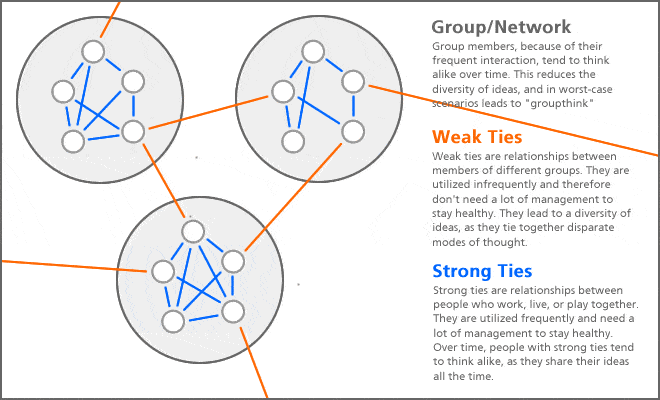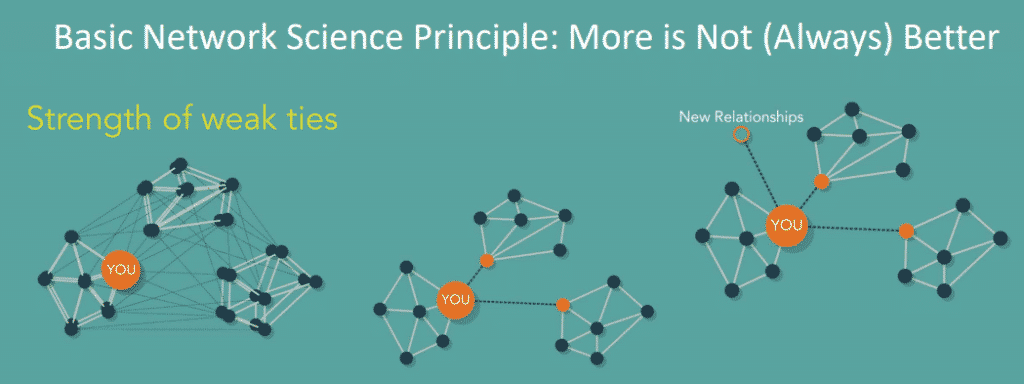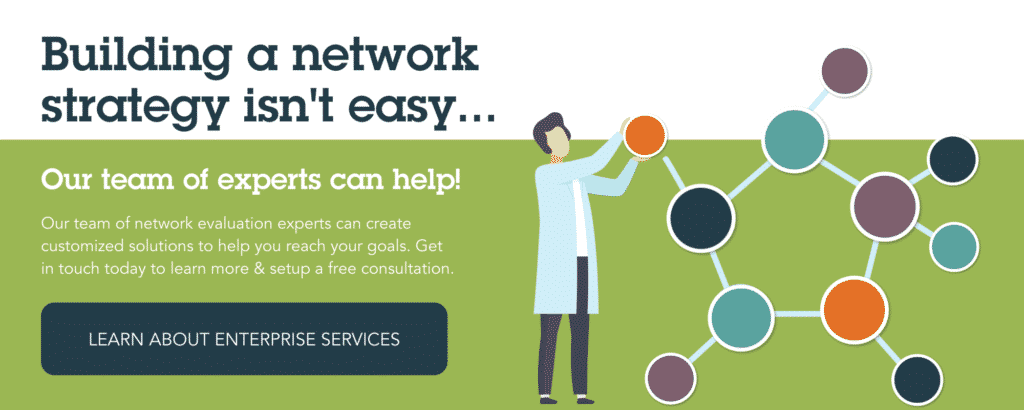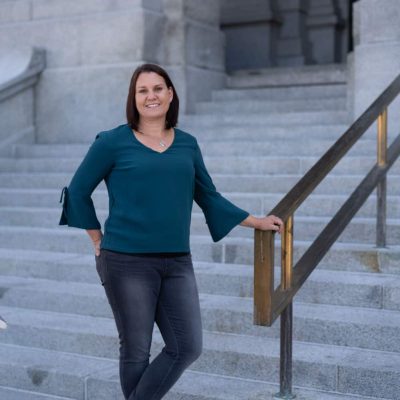We want to let you in on a network science secret – better networking is less networking

NETWORKING – IT’S A THING – EVERYBODY IS DOING IT…
The “network way of working” – that is, building diverse cross-sector relationships across people and organizations – prevails as the preferred organizing effort in society today. Who hasn’t heard how great collaboration is, and felt the excitement of being a part of something bigger than any one of us?
Without a doubt, cross-sector networks of organizations working tackling big social problems are the latest trend and solution to achieve social impact, and create efficient systems. We are embedded in personal networks that are growing extraordinarily fast, finding ways to connect with others in numerous types of social contexts, in person and online. And organizations are increasingly being incentivized (by funders) or required (by policymakers) to engage in cross-sector networks of organizations to get work done.
But is more networking, more relationship building, and more connections really better than anything else? As promising as this feels, it can be endlessly resource intensive. Given the uncertainty of just what benefit networks bring to your outcomes, it can become a relentless effort of building connectivity in an endless cycle of “more is better.” Without a strategy towards “less can be more”, it can all be for not.
THE SECRET TO A NETWORK SCIENCE INFORMED STRATEGY?
The lesson here is that to be a great networker, you don’t have to be super outgoing, someone who goes to every event, the person with the biggest list of partners, friends, or colleagues. Rather, the great networkers are those that think strategically about how they build their networks and intentionally keep them as small as possible to reach the greatest number of others. Specifically: what is the fewest number of connections to nurture and maintain, to the most trusted and well-connected people that will best help you achieve your outcomes? Or, how can we position ourselves as a hub, connected to a lot of spokes that are connected to a lot of people, without maintaining all the relationships each spoke gives us access to?
This may sounds good in theory, but what does this look like in reality? Well, we all know the kind of connectivity that is good, and that isn’t. However, very few people know how to manage these processes, or leverage them in any kind of strategic way that may actually result in better connectivity. We learn at an early age that more connectivity is better – the more friends we have, the more popular we are; the more people we know, the more likely we are to succeed professionally. However, network science (the science of the interconnectedness among human and organizational entities) is based on a definitive principle that more is not always better. Physicists and mathematicians have shown that in networks, each node can only hold so many connections before they are overloaded, and in turn, lose the collaborative advantage that makes networks so attractive to begin with! For me, this sounds really familiar – the endless emails, texts, online messages. I might feel like a networking hero, but the truth is, each one of us function like these nodes – we can only take on so much connectivity before we will begin to fail.
SO NOW YOU ARE A CONVERT OF THE LESS NETWORK IS BETTER NETWORKING MOVEMENT? TIME TO USE SOME NETWORK SCIENCE…
Creating a strategy to build more effective networks, rather than consuming endless amounts of connectivity, requires that you start thinking like a Network Scientist. But here is the good news – you already are a network scientist! Network science is such a cool, intuitive science that it’s one that everyone can claim, simply be the fact that you probably have wondered about, and solved, problems related to how you and others relate to one another. What you might not know, is that there are a few primary principles of network science that will take you to a whole new level of network science competency. And they are so simple and intuitive, you will wonder if you always knew this!
TWO NETWORK SCIENCE PRINCIPLES THAT WILL CHANGE EVERYTHING YOU THOUGHT YOU KNEW ABOUT NETWORKS
The Strength of Weak Ties Our strong ties are with people with whom we share a lot of commonality (in network science terms this is called “homophily” meaning “birds of a feather flock together”). For example, to people we often spend most of our time with – people who share common access to resources, share in our belief systems, have shared interests and like to do the same things as us. In contrast, our weak ties are with people who are different from us – they know things we don’t know about, they do things that we don’t do, they have access to knowledge and resources we don’t know about. Consequently, building network full of weak ties has a huge advantage to growing and strengthening a network.
This concept – the Strength of Weak Ties, a theory, published by Mark Granovetter1 in 1973, is fundamental to network science, and the strong desire we all have to build bigger networks of relationships. It explains the advantages to working across diverse boundaries and building networks of people and organizations that are different from us. It is the reason why we all love the idea of networking so much! However, it also leaves us with a complicated situation – building a network rich in weak ties may diversify and strengthen the resource sharing aspects of relationships, but applying this “more is better” approach puts the network at risk of getting overloaded.
AN ALTERNATIVE STRATEGY - FILLING YOUR NETWORK WITH HOLES
While the appeal to create a more diverse network is strong, we are equally challenged with the reality that we have limited relationship budgets – that is, limited resources to build and manage diverse networks. Ron Burt, a business scholar, who focuses on creating competitive advantage in careers, organizations, and markets via network strategies, recognized this dilemma and published3 a solution that emphasizes reducing redundancies in a set of network relationships. This strategy in turn creates intentional “holes” in the network, while maintaining key connections to leverage the collaborative advantage while strategically managing resources committed to building relationships.

HOW DOES THIS THINKING WORK IN PRACTICE?
The image below shows how this might work in practice. Imagine that you are the red dot in the network maps. In the network on the left, we see how each of us are embedded in our own social subnetworks, which are filled mostly by connections to our “strong ties”. We are continuously building out those networks, filling up all holes with weak ties to diverse partners and it quickly becomes chaotic and difficult to manage. In network science terms, we call this having a “closed network” – that is, a network where most of the possible connections that can exist, do exist.
This kind of network building happens commonly in our personal lives, but when it comes to our professional and organizational relationships, we simply do not have the time, budgets, or bandwidth to maintain this level of connectivity. In the center image below, Burt’s principle of creating structural holes is
implemented, where a more strategic approach is taken by keeping only a limited number (1-2) of connections to other diverse subnetworks. This enables us to leverage the collaborative advantage of the strength of weak ties, while limiting the number of resources required to maintain them. Ideally, those limited number of connections are to trusted, well connected people, who, when activated can connect us to the other connections in that social subnetwork. For example, if a subnetwork is a hard-to-reach population, or a group of policy-makers, we may work to maintain one trusted relationship to a “gatekeeper” or “broker” that when needed, can connect us to the others in that subnetwork.
That approach allows us to maintain our collaborative advantages, while expending fewer resources, and opening us up to building new relationships with others in new subnetworks (subsequently building more collaborative advantage to more weak ties).
People who take this approach have what we characterize as more “open networks.” Open networks are those that have more “space” and room to build more network connections, while devoting less, or at least more strategically directed, resources to building that network.

WANT TO BE A GREAT NETWORKER – DO LESS, BUT MORE STRATEGIC NETWORKING
In today’s social structures, there is propensity to value a large network, both in our personal lives, and across our professional and organizational boundaries. This approach emphasizes the idea that more networking is better networking; that focusing on collaborating across sectors will bring a certain type of collaborative advantage that can have positive personal, professional, and societal impacts.
But the lessons here caution that to really get the most advantage of your networks, you need to be strategic about how you approach them, with a focus on limiting the amount of network maintenance you have to do, but increasing value of each nurtured relationship. If nothing else, if you can start thinking this way about your networks, you will be a step ahead of the rest. If you start practicing these kinds of strategies, you will begin to instantly see how you can maintain a greater collaborative advantage while reducing your network connections.
If you want to be more sophisticated in your strategies, go out and collect data on your networks. Using an approach such as social network analysis, and tools like the PARTNER tool, you can begin to have an evidence-base by which to make these kinds of collaborative strategies, test the evolution of these ties over time, and if you can link them to outcomes, test the efficacy and success of your strategic approach. You can also look into the various trainings we offer on network leadership, evaluation and management by visiting our Network Leadership page.
- Mark S. Granovetter , “The Strength of Weak Ties,” American Journal of Sociology 78, no. 6 (May, 1973): 1360-1380.
- Huxham and Vangen. 2005. Managing to Collaborate: Theory and Practice. Routledge, New York, NY.
- Burt, Ron. 1995. Structural Holes: The Social Structure of Competition. Harvard University Press, Cambridge, MA.
About the Author: Dr. Danielle Varda
CEO, Founder, Professor, & Mother of Three Spirited Girls
Danielle is a scientist turned start-up founder, leading Visible Network Labs as CEO. Her combination of 20 years as a network scientist studying social connectedness and health, published author, 12 years as a tenured professor at the University of CO Denver, and her successful launch and scaling of the Center on Network Science came together in one big idea to start VNL. She is an entrepreneur, technologist, network scientist, fundraiser, and mother to three spirited girls. Her calling came when she realized her unique ability to develop technology solutions bridge complex systems science with everyday applications in communities, organizations, and business. She is a nationally known expert and keynote speaker on applied network science, with specific expertise in health system, public health system, entrepreneurial ecosystems, and educational system approaches. Danielle has published over 30 peer-reviewed articles on networks and their impact on health, well-being, and economic outcomes. Danielle leads VNL’s strategic partnership approach, is the company’s lead fundraiser, and has a vision for how to utilize network science to solve our most pressing and intractable problems.
In addition to her leading VNL, she is also an Associate Professor at the School of Public Affairs, University of Colorado Denver where she is Co-Director of the Center on Network Science, Director of the Nonprofit Concentration in the MPA program, and Advisor to the Dual MPA-MPH Degree. Additionally, she holds a secondary appointment in the Colorado School of Public Health, Department of Health Systems, Management, and Policy. She also has a courtesy Associate Professor appointment in the School of Information Sciences at the University of CO Boulder.






